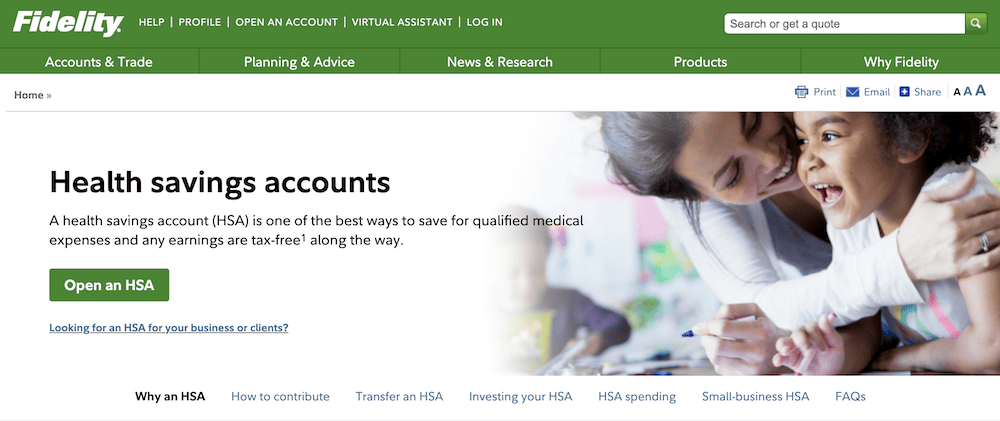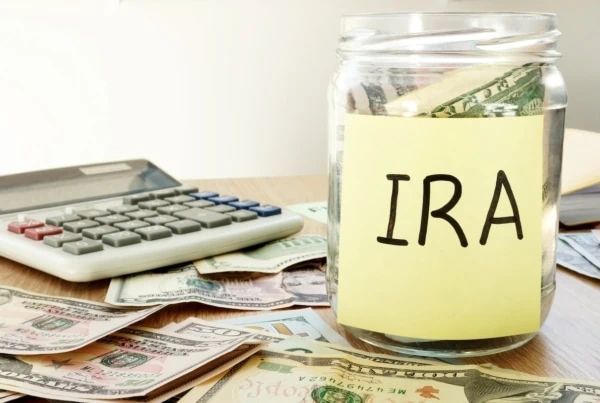It’s not a well-kept secret healthcare costs have risen faster than wages for many years. To protect their bottom lines, many employers have shifted the burden of paying for healthcare to employees. This trend has led to higher deductibles and lower coinsurance rates. It has also led to the creation of health savings accounts for those on qualifying high-deductible health plans. But some of you reading this might ask, “What is an HSA?”
Let’s explore the background of these instruments and how these tax-advantaged accounts function. Afterward, we’ll explore some common myths about the accounts and a new retirement strategy my wife and I plan to use with our HSAs.
Featured Financial Products
Table of Contents
What is an HSA?
Health Savings Accounts (HSAs) are tax-advantaged medical savings accounts available to people enrolled in high-deductible health plans. The accounts were created by federal legislation in 2003.
As you can read below, you do not have to be tied to an employer plan to qualify. HSAs are available through non-employer-based arrangements to those who qualify.
Who Can Qualify for a Health Savings Account?
Employees who work for an employer which offers high-deductible health plans (HDHP), or those plans which have the employee bear the burden of higher healthcare expenses up to a deductible limit and then coinsurance amounts, can establish an HSA for their employees to use. However, self-employed individuals and families may open an account as well so long as they have a HDHP.
There are requirements to have access to a health savings account, however. For 2025, the requirements for establishing or having access to a health savings account are:
- Insured (that’s you) must be covered by a HDHP
- HDHP minimum deductible for self-only coverage is $1,650 and $3,300 for family coverage ($1,700 and $3,400, respectively, for 2026)
- HDHP out-of-pocket maximum for self-only coverage is $8,300 and $16,600 for family coverage ($8,500 and $17,000, respectively, for 2026)
- HDHP coverage can be a traditional medical plan so long as the plan doesn’t cover the first dollar of medical expenses (except preventative care)
- Cannot have coverage by other comprehensive medical plan, nor enrollment in Medicare (HSA may be maintained after receiving coverage by Medicare but contributions cease)
Related: How Much to Save for Retirement by Age Group [Get Your Plan on Track]
Can I Set Up a Health Savings Account On My Own?
Starting a health savings account is not a difficult task if you know where to look and you meet the qualifications above. Typically, you can set up an account with:
- Banks
- Credit unions
- Insurance companies
- Brokers and financial advisors
- Other qualified financial institutions
The first three above will provide their own specified plans for you to use whereas online discount brokers and financial advisors will have multiple options for you to consider (they are a broker representing multiple possible financial institutions).
If you are interested in establishing your own account, reach out to one of the entities above and inquire about their process for opening an account.
Be cognizant of the fees and available investment options offered by each and see which one makes the most sense for your situation.
Where Can I Open a Health Savings Account?
If you want to invest your HSA balance (recommended), our top pick is Fidelity because the company offers the best options for self-directed investors. Here are some details about Fidelity’s HSA offerings.
Fidelity HSA
- Available: Sign up here
- Debit card: Yes
- Insured: Yes (Uninvested cash is insured)
- Minimum balance: $0
- Minimum to invest: $0 for Fidelity HSA, $10 for Fidelity Go HSA
- Investment options: Stocks, bonds, mutual funds, ETFs (investments depend on account type)
Fidelity offers two options for HSA accounts: the Fidelity HSA or the Fidelity Go HSA.
The self-directed Fidelity HSA is best for people who prefer to handle their own investments. With this account, you can invest in stocks, bonds, mutual funds, and exchange-traded funds (ETFs). It’s also a rarity in that it allows you to buy fractional shares of stock. You’ll also benefit from commission-free trades, minimal fees, and no account minimums. This HSA account also comes with a debit card that you can use for qualifying healthcare expenses.
These features make the Fidelity HSA a good option for those seeking the flexibility of a self-directed account, as well as individuals or families who might not have a ton of extra cash to set aside for healthcare expenses.
People seeking a managed account could opt instead for Fidelity Go HSA, a robo-advised HSA solution. Answer just a few questions, and Fidelity Go will build a portfolio for you. Funds in a Fidelity Go account are invested in Fidelity Flex mutual funds, which feature no management fees and often no fund expenses.
- Maintenance/other recurring fees: None
- Investment fees: Fidelity HSA: No fees. Fidelity Go HSA: No advisory fees for balances under $10,000; $3/mo. for a balance of $10,000-$49,999, 0.35%/yr. for balances of $50,000 and above.
- Minimum balance to invest: Fidelity HSA: $0. Fidelity Go HSA: $10.
- Investment options: Fidelity HSA: Stocks, bonds, ETFs, mutual funds. Fidelity Go HSA: Fee-free Fidelity Flex mutual funds.
- Maximum investment flexibility via self-directed Fidelity HSA accounts
- Low/no minimum to invest depending on type of account
- No fees for Fidelity HSA
- No fees on low- to mid-balance accounts for Fidelity Go HSA
- Can buy fractional shares
- Mobile app
- Bill pay
- FDIC-insured cash accounts
- SIPC-insured investment accounts
- Regressive fee structure for managed Fidelity Go HSA investment accounts
Who Should Consider a Health Savings Account?
For individuals or families with low healthcare expenses, a health savings account is a valuable tool to save for future health expenses.
If you have coverage from a high deductible health plan and have the ability to take advantage of the substantial tax benefits of a health savings account, it is a smart financial option.
Related: When is Having a Health Savings Account and HDHP a Bad Idea?
Why is a Health Savings Account Important?
A health savings account offers triple tax savings and can be extremely beneficial to employees enrolled in high-deductible health plans through their employer’s insurance program. The funds kept in these accounts can defray the costs of qualified health expenses which fall outside the coverage of traditional health insurance. They can also be used to cover other health-related expenses which are not entirely covered by your insurance.
These funds are contributed either as a payroll deduction directly from your paycheck or through a deposit made by you into the account.
If the contribution goes into my HSA by a payroll deduction, it is not subject to income taxes (and if the contribution comes from your employer as a benefit, those funds aren’t subject to employment taxes like Social Security and Medicare since this isn’t considered earned income).
Depending on your health savings account plan, there might also be options available for you to invest any HSA funds not used to pay medical expenses. For example, my current HSA provider offers savings and investment options to consider with the regular contributions I make each pay check.
Currently, I split my contributions 80% toward a low-cost S&P 500 index mutual fund available through the plan and 20% towards a high-interest savings instrument in the event I need immediate access to the funds. There is a minimum balance of $1,000 required for my account to be eligible for investing. Most accounts have a minimum balance requirement to access the available investing options.
The key to remember when considering investing your HSA funds is to find an HSA account which provides investing options where the first dollar invested goes into low-cost, diversified investments in reputable funds.
Be sure to avoid companies which require minimum balances for investing or charge large fees relative to your balance.
What Happens to My Unused Health Savings Account Funds at the End of the Year?
The key to this account is the ability to save your HSA funds for future eligible health-related expenses. Any unused funds will roll over from year to year.
Flexible Spending Accounts (FSAs) typically employ a “use it or lose it” feature, though some plans allow a limited amount of carryover (a maximum of $660 in 2025). On the other hand, with a health savings account, the balance rolls over indefinitely until the funds are used.
What Are the Annual Contribution Limits to a Health Savings Account?
Each year, the IRS sets annual contribution limits for HSAs. These limits are based on your HDHP coverage level (self-only or family).
For 2025, the self-only contribution limit is $4,300 ($4,400 for 2026).
For family coverage, the 2025 health savings account contribution limit is $8,550 ($8,750 for 2026).
You may contribute as a lump sum to meet these maximums (or lesser amounts) or multiple times throughout the year.
If you are 55 or older, you may contribute an additional $1,000 per year as a catch-up contribution.
Unlike 401(k) plans, if your employer makes contributions to your HSA account, these funds count towards the annual contribution limit.
Featured Financial Products
What Happens If I Use My HSA Funds for Nonqualified Expenses?
It is your responsibility to maintain documentation showing your funds were used to pay for qualified medical expenses. If funds are used for nonqualified expenses, the money will be taxed as income and subject to a 20% penalty.
If you mistakenly use your HSA for a nonqualified expense, you can return the funds to your HSA to avoid the penalty.
If you are 65 or older or enrolled in Medicare, you may use your HSA for non-medical expenses without incurring a tax penalty. Those distributions will be treated as normal income and subject to income tax at your regular federal tax rate.
Why Do Health Savings Accounts Exist?
Given the trend of increasing healthcare costs in America, employees fortunate enough to have health benefits offered through their employers are paying more for less coverage. Even worse, it doesn’t appear as though this trend will abate anytime soon.
As previously discussed, some HDHPs offer these accounts to provide a tax-advantaged method of saving for healthcare-related costs. In effect, participants save pre-tax dollars and can grow them tax-free until needed for medical treatment.
At withdrawal, qualified healthcare expenses can be paid with funds set aside in an HSA. But you may already know about this tax-saving power of an HSA. However, let’s dispel some common myths around HSAs and make sure we all know just how valuable saving in a HSA can be for dealing with healthcare expenses.
Common Myths About HSAs
-
HSAs Offer the Same Tax Savings as a 401(k) or IRA
HSAs do offer tax savings by helping you to lower your taxable income through pre-tax contributions. This is similar to traditional 401(k) and IRA contributions but differs in another important way. HSAs do not require you ever to pay taxes on withdrawals (assuming the HSA funds are used for eligible medical expenses).
Roth 401(k) and IRA contributions are taxed when contributed while traditional 401(k) and IRA accounts are taxed at withdrawal. Eventually, you’ll have to pay taxes on many of those funds. Your HSA comes with a triple-tax advantage: contributions, withdrawals (on eligible medical expenses) and earnings are all tax-free.
One final thing to note about these tax-advantaged accounts, not all states grant HSAs the same tax-advantaged status. Each state can decide to follow federal tax guidelines for HSAs or establish its own.
Please consult a tax professional regarding your state’s rules or visit your state’s Department of Revenue for more information.
-
An HSA Only Comes as an Employer-Sponsored Plan and Can’t Follow You to Another Job
Because HSAs are individually registered accounts, the assets contained within them belong to the account holder. This means if you change jobs or retire, you can still take the funds with you. They belonged to you at your previous employer, so why shouldn’t they at your next? The funds are portable. You own the account and all contributions, even if you change health plans, retire or leave your employer.
-
You Lose Your Unused Contributions Each Year
Another added bonus for the HSA: unlike flexible spending accounts (FSA), the entire HSA balance rolls over each year. HSAs provide more flexibility than their predecessor, the FSA.
The difference between a FSA and HSA is that FSAs often require the balance set aside each year to be spent in full or forfeited (“use it or lose it”), though some FSAs allow for a partial carryover (limited to $660 in 2025). HSAs have the advantage of allowing funds to accumulate over time and potentially be invested to allow compounding returns on these funds should the HSA account provider offer these options.
Related: Form W-2, What You Need to Know
Are Health Savings Accounts the Best Option for You?
For starters, HSAs require the insured to be enrolled in a qualifying high deductible healthcare plan. In some cases, it makes sense to use this type of policy if the insured expects minimal healthcare costs. Commonly, young people, also referred to as “invincibles,” use high deductible healthcare plans for this very reason. When a person is young and healthy, it is less likely they will need recurring, expensive healthcare coverage.
As people age and have families, visits to doctors, medication prescriptions, and medical care become more common. In this case, having a low-deductible healthcare plan makes sense.
These plans have the insurer begin paying for healthcare needs at a lower out-of-pocket dollar amount and makes more financial sense. If you are a person or family in good health with low expected healthcare needs, using an HSA to accumulate funds in a tax-advantaged account makes sense.
If you can invest in index funds in your plan, taking advantage of those and allowing the tax-advantaged investments to grow tax-free can be a great strategy to assisting with medical expenses later in life.
Health Savings Accounts, the New Retirement Strategy
According to an estimate by Fidelity, the average American couple will need $280,000 to cover out-of-pocket health care costs in retirement. This accounts for coverage received under Medicare.
Using an HSA to meet this gap for health, dental, hearing and vision expenses is a smart strategy. Because you can use HSA funds to pay for qualified healthcare expenses at any point, an optimal consideration would be leaving the funds in your account in low-cost investments until retirement. If you can avoid using the HSA funds before retirement and let compounding grow your annual contributions, you shouldn’t experience a funding shortfall when you need it most: in retirement on a fixed income.
Another strategy is called “cashflowing your HSA.” Under this arrangement, you track your medical expenses over multiple years and pay for them using your after-tax cash flow while leaving your HSA funds in the account to compound. This can be used as a bridge to cover your financial needs between an early retirement and when you can access your tax-advantaged retirement accounts without incurring a penalty. You can also use this to smooth out cash flow needs independent of retirement cash needs.
At its best, this strategy has you track medical expenses and reimburse yourself with funds which receive the triple tax advantage mentioned earlier. For this reason, it can also be used as a supplemental emergency fund or supplemental income at retirement at any point. The key is you must track your medical expenses along the way.
This strategy is relatively new and likely hasn’t been used by many people at this point. The reason for this is HSAs have only been around for about 15 years and didn’t gain much genuine traction until the past decade after the Affordable Care Act passed. It is unlikely there are many soon-to-be-retirees who opt to use a high-deductible health care plan when they would more than likely be better served under a low-deductible plan.
My wife and I have considered this possibility for smoothing out any cash flow needs as we age. We know it will be important if we intend to follow a new DIY retirement strategy. For now, we have been fortunate to avoid any major medical expenses, largely because we’re young and in good health.
One thing we know for sure is we will continue funding my HSA account available through my work and leave the option available to us should we need it. Because healthcare needs increase with age, having tax-advantaged compounded funds available to you is a great retirement strategy.
Featured Financial Products
Related:







![SEP IRA Contribution Limits [2025 + 2026] 8 SEP IRA contribution limits](https://youngandtheinvested.com/wp-content/uploads/SEP-IRA-contribution-limits-600x403.webp)

![How to Make $50 Fast [Several Ways to Get $50 Or More] 10 how to make 50 fast](https://youngandtheinvested.com/wp-content/uploads/how-to-make-50-fast-600x403.webp)
